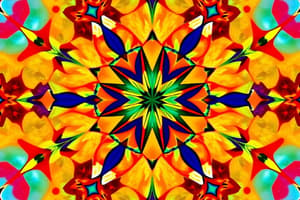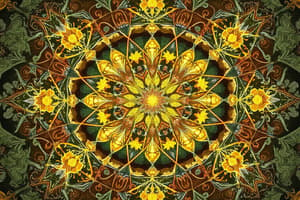Podcast
Questions and Answers
What is the condition for a molecule to be optically inactive?
What is the condition for a molecule to be optically inactive?
A molecule is optically inactive if it possesses a plane of symmetry, meaning its mirror image is superimposable.
What happens to the mirror image of a molecule when it has a chiral carbon atom?
What happens to the mirror image of a molecule when it has a chiral carbon atom?
The mirror image is not superimposable when a molecule has a chiral carbon atom.
What is the effect of a racemic mixture on optical rotation?
What is the effect of a racemic mixture on optical rotation?
The net optical rotation of a racemic mixture is zero.
What is the difference in physical properties between enantiomers?
What is the difference in physical properties between enantiomers?
What is unique about the biological properties of enantiomers?
What is unique about the biological properties of enantiomers?
What is the difference in chemical properties between enantiomers?
What is the difference in chemical properties between enantiomers?
What is the significance of chiral carbon atoms in a molecule?
What is the significance of chiral carbon atoms in a molecule?
What is an example of a molecule with a chiral carbon atom?
What is an example of a molecule with a chiral carbon atom?
What is the condition for a carbon atom to be asymmetric, and how many optical isomers are possible if a molecule has two asymmetric carbon atoms with different terminal groups?
What is the condition for a carbon atom to be asymmetric, and how many optical isomers are possible if a molecule has two asymmetric carbon atoms with different terminal groups?
What is the difference between enantiomeric pairs and diastereomeric pairs?
What is the difference between enantiomeric pairs and diastereomeric pairs?
What is a meso form, and how is it different from an enantiomeric pair?
What is a meso form, and how is it different from an enantiomeric pair?
What are the conditions for a molecule to be optically active?
What are the conditions for a molecule to be optically active?
How many isomers are possible for a molecule with two asymmetric carbon atoms having the same terminal groups?
How many isomers are possible for a molecule with two asymmetric carbon atoms having the same terminal groups?
What is the difference between an enantiomer and a diastereomer?
What is the difference between an enantiomer and a diastereomer?
What is a racemic mixture, and how is it related to enantiomers?
What is a racemic mixture, and how is it related to enantiomers?
How many asymmetric carbon atoms are present in CH3 − (CHOH)3 − CH3, and what is the total number of optical isomers possible?
How many asymmetric carbon atoms are present in CH3 − (CHOH)3 − CH3, and what is the total number of optical isomers possible?
What is the condition for optical activity in a molecule?
What is the condition for optical activity in a molecule?
What is the term for optically active isomers that are not related as mirror images?
What is the term for optically active isomers that are not related as mirror images?
What is the term for a molecule that rotates plane polarized light clockwise?
What is the term for a molecule that rotates plane polarized light clockwise?
What is the term for a molecule that has a non-superimposable mirror image?
What is the term for a molecule that has a non-superimposable mirror image?
What is the term for optically active isomers that are related as mirror images?
What is the term for optically active isomers that are related as mirror images?
What is the term for a mixture of equal amounts of dextrorotatory and leavorotatory isomers?
What is the term for a mixture of equal amounts of dextrorotatory and leavorotatory isomers?
How do enantiomers differ from each other?
How do enantiomers differ from each other?
What is the importance of checking for a plane of symmetry in determining optical activity?
What is the importance of checking for a plane of symmetry in determining optical activity?
Flashcards are hidden until you start studying
Study Notes
Stereochemistry and Optical Isomerism
- A molecule with a plane of symmetry is optically inactive, and its mirror image is superimposable.
- Planar molecules are optically inactive because they possess a plane of symmetry.
Chiral Carbon Atoms
- A molecule with one chiral carbon atom has 2^(1) = 2 optical isomers, which are related to each other as mirror images.
- Example: Lactic acid, which has a specific rotation of +2.67°, and its mirror image (-) lactic acid has a specific rotation of -2.67°.
Properties of Enantiomers
- Physical properties like melting point, boiling point, and refractive index are the same for enantiomers.
- Optical rotation is opposite for enantiomers.
- Chemical properties are the same with optically inactive reagents, but show differences in reactivity with optically active reagents.
- Biological properties like smell, taste, and drug action show marked differences between enantiomers.
Molecules with Two Asymmetric Carbon Atoms
- If a molecule has two asymmetric carbon atoms with different terminal groups, 2^(2) = 4 optical isomers are possible.
- Example: 2,3-dihydroxy butanoic acid, which has two asymmetric carbon atoms and four optical isomers.
Molecules with Two Asymmetric Carbon Atoms with Same Terminal Groups
- If a molecule has two asymmetric carbon atoms with the same terminal groups, only one enantiomeric pair and an optically inactive form (meso) exist.
- Example: Tartaric acid, which has two chiral carbon atoms and three optical isomers (one enantiomeric pair and one meso form).
Problem 4.1.1
- CH3 - (CHOH)3 - CH3 has two asymmetric carbon atoms, and 2^(2) = 4 optical isomers are possible.
Problem 4.1.2
- CH3 - CH(NH2) - CHO and 2-butanol are optically active because they have asymmetric carbon atoms with different groups attached.
Problem 4.1.3
- C6H14 has several possible isomers.
Geometrical Isomerism in Rings
- Geometrical isomerism is also possible in ring structures like cyclopropane, cyclobutane, and cyclohexane due to restricted rotation of C-C bonds involved in rings.
- In molecules like cyclohexane, although bond rotation is possible, the 'cis' isomer never transforms into the 'trans' isomer, and the isomers can be separated.
Optical Isomerism
- Certain substances possess the property to rotate plane-polarized light and are called optically active substances.
- The substance that rotates plane-polarized light clockwise is called dextrorotatory (indicated as d or +), while the one that rotates plane-polarized light anticlockwise is called levorotatory (l or -).
- The d and l isomers have the same degree of rotation but opposite signs.
- These molecules are related to each other as their mirror images and are called enantiomers.
- The optically active isomers that are not related as mirror images are called diastereomers.
Condition for Optical Activity
- Non-superimposability of the mirror image of a molecule with the original molecule is the only condition for optical activity.
- A molecule having a chiral carbon atom (all four groups attached to the C-atom are different) has non-superimposable mirror image and thus is optically active.
Studying That Suits You
Use AI to generate personalized quizzes and flashcards to suit your learning preferences.




